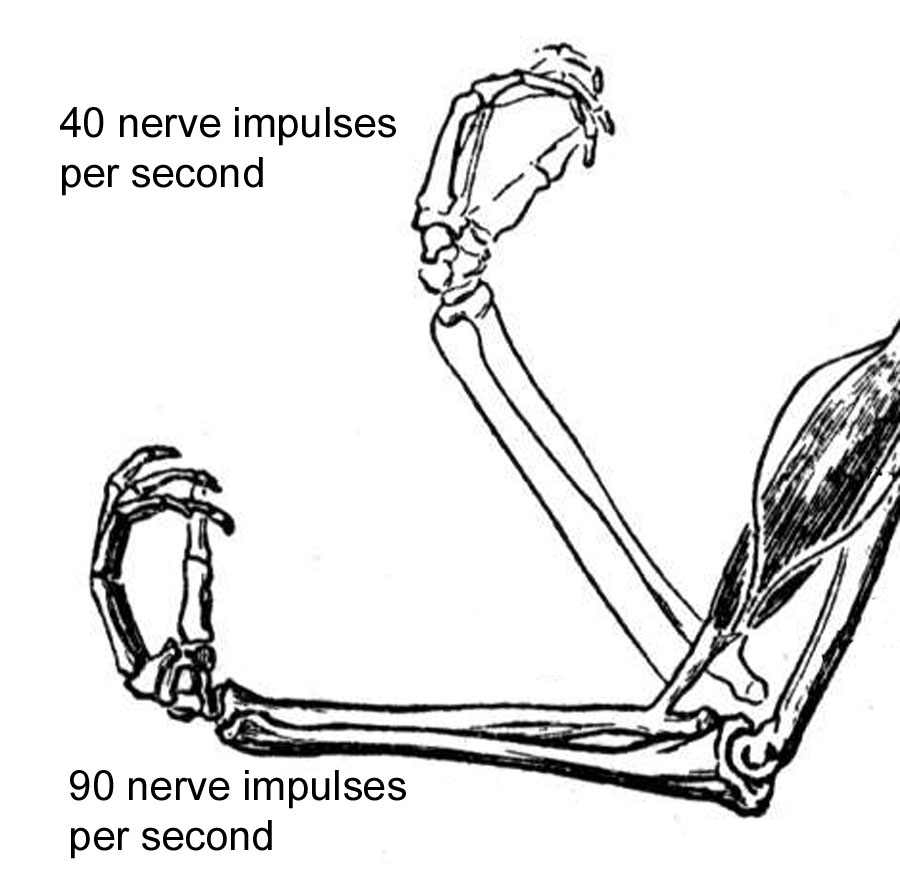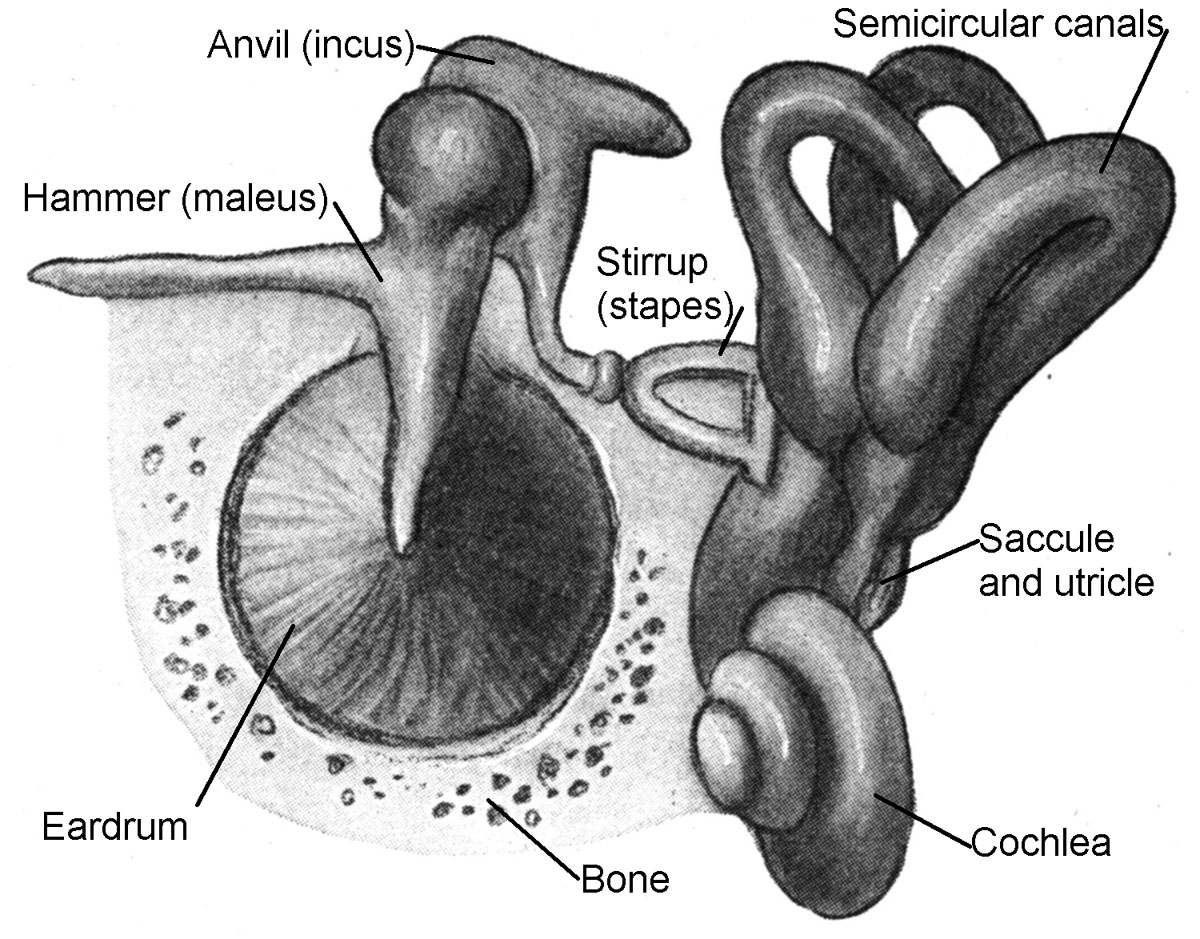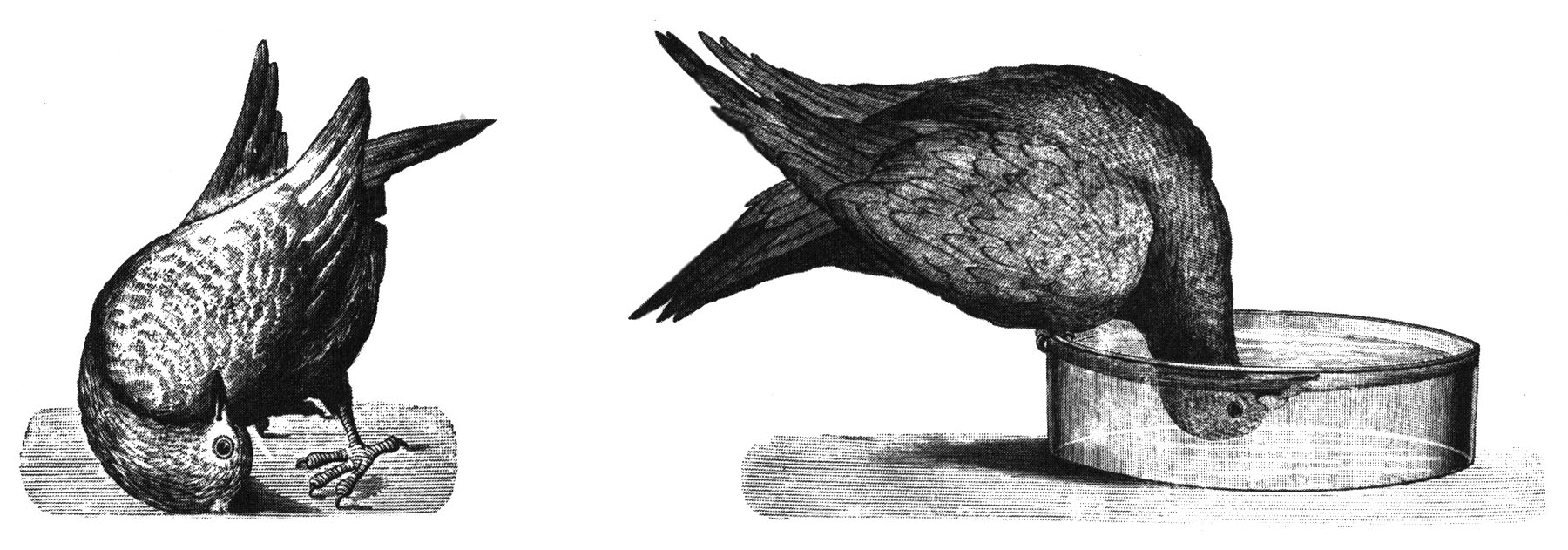Copyright © 2007-2018 Russ Dewey
Kinesthesis and Equilibrium
We have surveyed the five senses described by Aristotle: vision, audition, olfaction, gustation, and touch. All five are directed outward to receive stimuli from the outside world.
Two other important senses, kinesthesis and equilibrium, involve sensitivity to internal events: position and motion of the body. Kinesthesis and equilibrium are proprioceptive senses, from the root proprio, which means belonging to the body. Kinesthetic receptors detect change in body position.
What is kinesthesis? What does proprioceptive mean?
The kinesthetic sense monitors the position and movements of muscles, bones, and joints. Through the sense of kinesthesis you can tell, even with your eyes closed, where your arms are located.
When you play any sport, when you drive a car, when you move around, you need to know where your limbs are located so you can move them to the right positions. Receptors in the joints and tendons send the brain information about the angle of your limbs.

Nerve impulses code the angle of a limb.
For example, a neuron connected to kinesthetic receptors in the elbow fires a certain number of impulses when the arm is outstretched. If the arm is at a 45-degree angle, the cell might fire 40 impulses per second. If the arm is at an angle of 60 degrees, the cell might fire 90 impulses per second.
Where are the kinesthetic receptors located, and what do they detect?
Kinesthetic receptors are primarily stretch receptors located in the muscles, joints and tendons. To activate a knee-jerk reflex, a doctor taps the tendon below the kneecap with a rubber hammer.
The tap of the hammer momentarily stretches the patellar tendon, which runs from the patella (kneecap) to the muscles of the lower leg. When the tendon is tapped, stretch receptors send impulses to the spinal cord.
Motor neurons in the spinal cord send impulses back to the muscle of the leg, making it twitch. This reflex system helps keep us upright; when we lean, stretch receptors activate leg muscles to correct the lean and pull us back into a vertical position.
Equilibrium (Balance)
The sense organs for balance are located near the inner ear, protected by the same hard bones of the skull that surround the cochlea. When a person suffers inner ear damage, the sense of balance is often affected, because these sense organs are in close proximity. However, they are separate systems.

Structures used by the sense of equilibrium are located near the cochlea and the bones of the middle ear.
This diagram shows the relationship of the ossicles (bones of the middle ear) to the vestibular apparatus: the organs for the sense of equilibrium. The vestibular system is on the right.
The vestibular system consists of two main parts with slightly different functions: the semicircular canals (the loops) and two chambers under the canals: the saccule and the utricle.
The loops (semicircular canals) and sacs (saccule and utricle) are collectively called the nonauditory labyrinth or just the labyrinth. The entire labyrinth is filled with a fluid called the endolymph, the same fluid found in the cochlea.
Where are sense organs for equilibrium? What is the vestibular apparatus?
The semicircular canals are rotary motion detectors. When you turn your head in any direction, you move the fluid in the canals (the endolymph).
As the endolymph moves in the semicircular canals, the liquid stimulates hair-
What is the specific stimulus for the semicircular canals? How do they work?
Pierre Flourens, a French anatomist, discovered the vestibular system. He believed it was part of the auditory system. He was disappointed in 1824 when he removed the vestibular system in pigeons and found their hearing unaffected.
However, the birds showed other peculiar reactions. They could no longer maintain normal head and body position.

Birds with their vestibular systems removed
What did Flourens observe when he removed the vestibular system from pigeons?
The vestibular apparatus also includes another system, besides the semi-circular canals: two structures called the sacs, the saccule and utricle. These two chambers are linear motion detectors, which means they detect acceleration and deceleration: movement that can be in a straight line.
Within the saccule and utricle are crystals called otoliths (ear stones) surrounding modified hair cells. When the body accelerates or decelerates, the weight of the otoliths bends the hair cells, much as a weight on the end of a spring would bob back and forth if you accelerated or braked a car.
Once again the transduction process (the process of converting information from one energy form to another) is carried out by modified hair cells. Cilia, modified hair cells, generate electrical potentials triggering nerve impulses to the brain.
What are the saccule and utricle? What role do the otoliths play?
The otolith crystals look splendid in images from electron microscopes, like finely cut gems. Unfortunately, as decades pass, the crystals dissolve in the endolymph fluid.
By age 70, some of the crystals are gone. Fragments of the remaining otoliths may dislodge suddenly and tumble down on the hairs of the saccule and utricle, creating sudden imbalance or vertigo. This can cause people in their 70s or older to fall down suddenly, sometimes causing broken hips.
What do the otoliths look like under a microscope? What happens to the otoliths in old age and what sort of accident can this produce?
Motion Sickness
Motion sickness is caused when signals from the sense of equilibrium do not mesh with signals from the sense of vision. In a moving car, the sense of sight indicates motion, but the kinesthetic sense tells the brain that the body is sitting still.
The disagreement between visual and equilibratory signals causes motion sickness in some people. Sea sickness, a variety of motion sickness, is caused the same way.
What causes motion sickness?
One cure for motion sickness is to fixate one's gaze on the horizon. In an airliner or on a cruise ship, motion sickness can be worse if you stay in a room or cabin.
The room or cabin looks motionless. The sense of equilibrium responds to up and down motions of the craft, but this does not match the sense of vision showing a motionless room.
On a ship, the best solution is to stare at the horizon, the line in the distance where the earth or sea meets the sky. Then the visual system receives accurate information about how the body is tilted. The signals from visual system match the sense of equilibrium, and motion sickness is lessened.
Why does the body have this response to mismatched signals from the senses of sight and balance? Triesman (1977) proposed an "evolutionary hypothesis," noting that poisonous substances disturb the delicate coordination of vision and balance.
The sensitivity of this system to poisoning meant, over evolutionary time, feelings of dizziness and loss of balance could be used as an early indicator of poisoning. Animals that vomited when dizzy were more likely to survive and reproduce.
We are left with the unfortunate results, hard wired into our bodies. Harmless mismatches between vision and the sense of equilibrium, caused by traveling in a car or boat, can make us sick. Fortunately, a common over-the-counter medicine (dramamine) usually relieves these feelings.
This phenomenon is the bane of the virtual reality gaming industry. Nausea is a common side-effect of spending time in a virtual reality environment. A VR headset gives visual cues of tilting and whirling, while the sense of equilibrium reports no such movement.
What is an evolution-based theory of motion sickness? Why does it occur in virtual reality games?
Illusions involving the sense of equilibrium provoke a "gut reaction". This was demonstrated in the 1860s with an amusement park novelty called the haunted swing. As described by R.W. Wood (in Cohen, 1969):
I was much interested in the curious sensations produced by the swing at the Midwinter Fair in San Francisco [in 1894]. On entering the building, we found ourselves in a spacious cubicle room, furnished with sofa, table, chairs, a massive iron safe, and a piano, together with other minor articles.
But the most conspicuous object was the huge swing, capable of holding forty or more persons, which hung in the center, suspected from an iron cylinder passing through the center of the room. Each vibration of the swing caused those peculiar "empty" sensations that one feels in an elevator...
...We were then told to hold on tightly as the swing was going clear over, and sure enough, so it did.... Many persons were actually made sick. Many said that they could scarcely walk out of the building because of dizziness and nausea....
How did the "haunted swing" work, and what effect did it have on passengers?
The device was worked in the following way: The swing proper was practically at rest, merely being joggled a trifle, while the room itself was put in motion, the furniture being fastened down to the floor, so that it could be completely turned over....
The curious and interesting feature however was, that even though the action was fully understood, as was my case, it was impossible to quench the sensations of "goneness within" with each apparent rush of the swing. (In Cohen, 1969)
---------------------
References:
Cohen, J. (1969) Sensation and perception: II. Audition and the minor senses. Chicago: Rand McNally.
Treisman, M. (1977) Motion sickness: an evolutionary hypothesis. Science, 197, 493-495.
Write to Dr. Dewey at psywww@gmail.com.
Don't see what you need? Psych Web has over 1,000 pages, so it may be elsewhere on the site. Do a site-specific Google search using the box below.
